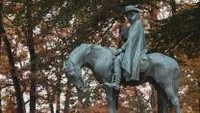“This man has been called ‘The American Saint,’
‘The Prophet of the Long Road.’”
In the United States, there are towns and cities, hospitals, homes, and schools,
from Maine to south Georgia and beyond named for Methodist leader Francis Asbury.
The Rev. Alfred T. Day III: “He was a frontiersman and a pioneer. He could have given Lewis and Clark a map to follow before they embarked on their journey and told them which roads to take and which roads were dead ends.”
Asbury brought Methodism to America in 1771, and over the next 45 years, he covered some 265,000 miles on horseback, bringing the Good News to the most remote corners of the New World.
The Rev. Alfred T. Day III: “The Methodist message that he brought was that God’s love can be experienced by everyone and that once it’s experienced by everyone the Holy Spirit takes up residence in your life and makes a difference.”
The son of working class parents in England, Asbury received little formal education. He apprenticed as a metalworker and became a local lay preacher. At age 22, John Wesley appointed him to serve as a missionary among the American settlements. His became a life on the road and Asbury never married.
Dale Patterson, General Commission on Archives and History: “We tend to think it was easy. We tend to think it was a direct application. But it was actually quite different. A British Methodist traveling on his circuit could usually get to a town on the same day—go from one town to the next. When you start across the Appalachians, or even across the Potomac, you could travel days before you got to a town, and a day or so from one farm to the next. And once you got into the frontier it was even more lonely.”
And there were more challenges in this new mission field.
Dale Patterson: “There were Methodists who said ‘We need to be able to serve communion. We need to be able to do these things.’ No one was ordained at that point. And Wesley struggled with that. So he set apart Coke to ordain Asbury as one of the other leaders of the Methodist Movement, especially establish a denomination, which was called the Methodist-Episcopal Church.”
Under Bishop Asbury’s direction, the Methodist Episcopal Church grew from 1,200 to 214,000 members and more than 700 ordained preachers. Among the men he ordained was Richard Allen of Philadelphia, the first African American minister in the United States.
Dale Patterson: “Someone pointed out that Asbury never really asked any of his preachers or pastors to do anything that he didn’t do.”
Asbury set a high standard by his own example but the constant travel proved too much for some in his charge. He kept a book with detailed critiques of his preachers.
Dale Patterson: “It would be, you know, ‘Jones’ and the word ‘useful’ next to it. ‘Peters, a bawler’ which means as he sings or he preaches he just sort of kinda yells constantly. He’s a bawler. Someone else, ‘needs practice.’”
Rev. Alfred T. Day III: “There were times in the conflicts, in the development of the American Methodist Church in the colonial era when he could have drawn a very hard line in the sand. But he seemed to have the knowledge and insight to know that when enforcing the rules too strictly might have a negative and deadly effect on his developing the American Methodist Church and the American Methodist church of his legacy by 50 to 75 years after his life, was the largest church body in America.”
Dale Patterson: “There’s a statue of him in our nation’s capital. I think it’s appropriate there’s a statue here at Drew in one of our seminaries. Asbury’s road goes through all those places. Asbury was one who reached out, he traveled, he spoke to a variety of people. He was comfortable talking to the upper crust and he was comfortable talking to slaves. He was comfortable talking to backwoods poor people and shopkeepers. I think that statue reminds us that the church needs to be in all of these places, reaching out in all of these kinds of ways.”
More Info: History www.UMC.org Go to; General Commission on Archives and History


